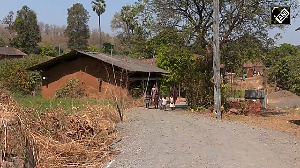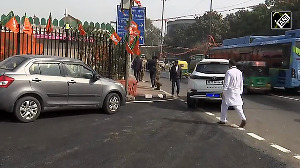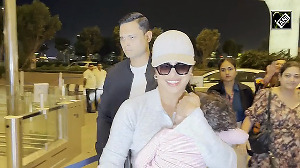To understand Rajesh Khanna's maniacal craze, one needed to have been born in the 1960s.
What you see today in television re-runs is a mere rewind into shredded fading memories.
It was sheer madness, says Sanjay Jha.
In 2006, I wondered about my childhood obsession Rajesh Khanna. His celluloid comeback seemed a remote possibility; the commercial format of the Hindi film had changed dramatically not allowing for the familiar character-actor roles of the past.
His brief flirtations with even the idiot box were not really spectacular, befitting his grandiose halo. Khanna's political career had been in virtual hibernation ever since his defeat to Jagmohan in the New Delhi parliamentary polls. And one did not see him often gracing Page 3. So just where was the erstwhile charismatic man who got us addicted to matinee shows on Friday afternoons?
In the early 1970s, I was such a Khanna fan that I would surreptitiously call Bombay theatres like Maratha Mandir, Roxy, Super and Minerva etc from Poona on my father's official STD line on Friday evenings to gather if The Phenomenon's films were indeed running housefull.
It was the beginning of a crazy roller-coaster ride of a hero-unknown fan relationship, perplexing and inexplicable to the ordinary, but largely rational to those who can comprehend that inane sentiment that commands that rather quixotic equation.
Khanna's abrupt fall from halcyon heights left us die-hard mad-hatters devastated. Even years later, I thought Khanna deserved redemption. I called his home number at Aashirwaad ostensibly as a curious journalist wanting a sound byte.
In reality, I had a clear agenda; why doesn't Rajesh Khanna do an autobiography of an incredible career and byzantine life, peppered with those unknown secrets and hidden facts that explain the mind and heart of a lonely superstar in virtual exile, but one who was once the arrogant emperor with royal robes?
I wanted to offer to co-author the book with him. The house-help who answered said that Khanna was traveling, but could I call back? Alas I didn't, consumed by my daily travails. I wish I had.
Two weeks ago I was taking an early morning flight to Bangalore and as we headed towards the Western Express highway after crossing the Bandra-Worli sea link, the famous mustard-colored Lilavati hospital gradually appeared in view. It felt acutely strange.
The Phenomenon was there somewhere on the 11th floor apparently struggling with an unknown, but surely, a debilitating illness. I believe there were few visitors. At close proximity stood several film studios where his appearance once created traffic jams and a commotion hard to contain.
Screaming fans sporting his trademark Guru-Kurta, film-photographers battling the mayhem, love-struck Juliet's ready to slash wrists and kiss his car's bonnet, curious onlookers simply amazed at the uncontrollable hysteria. Not too far away from that famous address in town either, Aashirwaad on Carter Road, where people from all parts of the world would come to just see where the King lived, at least momentarily fooling themselves that they were merely a few hundred feet away from the greatest superstar India had ever seen. Or will ever see -- Rajesh Khanna. Sorry, the late Rajesh Khanna.
I first saw Khanna in the ultimate romantic classic Aradhna in the memorable scene where Sharmila Tagore throws a bucket of cold water on him inadvertently. The audience went completely berserk.
It was to happen again in Andaz when he appeared suddenly on a Royal Enfield (Zindagi Ek Safar Hai Suhana) with a scarf circumventing his neck, black goggles perched tantalisingly on his nose bridge as Hema Malini hung precariously as a pillion.
It was to be seen to be believed. And when he sang Vaada Tera Vaada in Dushman, a rogue truck-driver with a golden heart, people threw coins right on the aisle and danced alongside. Unparalleled, unprecedented, unmatched since.
To understand Khanna's maniacal craze, one needed to be have been born in the 1960s. What you see today in television re-runs is a mere rewind into shredded fading memories. It was sheer madness.
The golden phase of Khanna's career included sensational hits that came at breakneck speed and rapid succession; Do Raaste, Ittefaq, Bandhan, Kati Patang, Anand, Safar, Amar Prem, Roti and Sachcha Jhoota, a staggering 15 commercial bonanzas. It was intoxicating stuff and could drive the sanest cuckoo.
Khanna was but human. Worse, hugely egotistical, a toxic combination. A string of eminently forgettable films which turned out to be box-office turkeys abruptly halted that serendipitous honeymoon in the zenith.
Khanna made dying into an art form, and audiences wept inconsolably in deep throbs in Safar, Namak Haram and Aradhna. His haunting Babu Moshai in Anand's final scene can give you the goose-bumps even today.
But it was with Haathi Mere Saathi that Khanna captured those susceptible cuddly hearts, the entire young brat population as well. He was the fountainhead of family entertainment, with the sobbing-sentimental women and the young romantics queuing up for first day first show.
The Phenomenon was unassailable, invulnerable, insuperable. The R D Burman-Kishore Kumar-Khanna trio was a ready-made cocktail for the cash counters. The Khanna-Mumtaz pairing had all the spontaneous energy of impetuous lovers playing hard-to-get, while Sharmila Tagore added chemistry that can be best described as visceral love; whether it was the latent lust in Roop Tera Mastana or the 'I hate tears, Pushpa' in the legendary scene from Amar Prem.
He also experimented with some off-beat stuff in Aavishkar, besides playing a psychopath murderer in Red Rose. But only Kaka could destroy this glittering glassy hard-earned kingdom. He did. Perhaps he preferred splendid isolation to the gnawing insanity of it all.
Namak Haraam in 1973 became the turning point in Khanna's career, as it did for Amitabh Bachchan, his real nemesis whom he had once contemptuously dismissed. Hrishikesh Mukherjee's film based on inter-class conflict between the license-Raj industrialist's wayward son and his labour-leader lower middle-class best friend was an epic drama.
But the author-backed role of a sulking, emotional fireball suited Bachchan. Khanna's mild-mannered, mature, mollifying character though brilliantly underplayed got murdered, like Shashi Kapoor's in Deewar. The superstar's reign had begun raining off as Bachchan became his direct adversary, who chose films with greater circumspection.
Fortuitous circumstances favoured the lanky Bachchan too, albeit immensely talented. One of them was the 1975 declaration of Emergency, which created an inimical, imperceptible anti-establishment mood. The aura of soft, charming romanticism gave way to violent, unrestrained tumult.
The Angry Young Man was born, intemperate, resolute, a muscular one man demolition squad. Bachchan's unusual towering height, impeccable baritone and long side-locks helped.
Concomitantly, Khanna chose pedestrian, egregiously bad films like Maalik, Hamshakal, Shehzada, Aaina, Maha Chor, Chalta Purza, Raja Rani etc. His attempts at production proved disastrous, plunging him into financial bankruptcy. One was Alag Alag and the other, a last-ditch attempt at career resuscitation called Jai Shiv Shankar, co-starring estranged wife Dimple Kapadia. It remains in the cans.
Khanna's strange marriage to teenager Dimple Kapadia looked like a trite script from a tyro filmmaker; including melodramatically taking his old steady girlfriend Anju Mahendroo on a false trail to Khandala.
Frankly, a starry-eyed Kapadia and a haloed superstar with quicksilver mood swings made odd bedfellows; the marriage, of course, created massive publicity deserving of heavenly misfits. The acrimonious break-up, and their respective high-profile dalliances with co-stars made equal mast-head copy.
Khanna's predicament was that a dissipating professional career was accentuated by a controversial private life; he stumbled and fell.
Bachchan lorded Bollywood becoming famously a 'one-man industry', Khanna had became a peripheral innocuous threat despite a late desperate surge with Souten, Fifty Fifty, Chhaila Babu and Avtaar. Jeetendra, Rishi Kapoor and a resurrected Dharmendra and the like had also surreptitiously nibbled away at Khanna's core audience.
That era also coincided with a sudden spurt of multi-starrers which saw the re-emergence of mediocre heroes, but which Khanna's ego studiously, strictly forbade. His later choices in the same genre were terribly abysmal. But the truth is that as Khanna ebbed, the 1980s saw the worst of Hindi cinema, violent films, kitschy sets, rehashed formula stuff, and Himmatwala reigned.
When the erstwhile The Phenomenon entered electoral politics in 1991, it signalled his grudging acceptance of his fragility in tinsel-town. Here too fate dealt Khanna a lethal blow; he almost blew L K Advani off in New Delhi constituency finally losing by a mere 1,000 votes, although comeuppance happened in 1992 when he trounced Shatrughan Sinha.
But by 1996 the Congress had become extremely wobbly, and he seemed caught in a dilemma between sporadic film roles or New Delhi. He floundered once again. The biggest romantic of Hindi cinema was also its biggest loner.
What you saw in the Havells ad is a nebulous apparition of a superstar that never can be replicated in a digital download, multi-screen multiplex age where a golden jubilee is an anachronism. There is no endurance anymore beyond two-weeks even if it is Rs 100 crores. But Rajesh Khanna's transitory madness has endured. His life is aptly captured by the song Zindagi Ka Safar Hai Ye Kaisa Safar, Koi Samjha Nahin Koi Jana Nahin.
Khanna's tale is somewhere incomplete. To have seen such dizzying heights of heady fame and then to experience such impenetrable oblivion requires some inner toughness. Anonymity can be dreadful for someone accustomed to being serenaded wherever, whenever. And now death. But as Bachchan's voice-over says in Anand, 'Anand mara nahin, Anand marte nahin'.
Khanna's life was colourful, complex, convoluted, and profoundly impactful. Even if he had lived another twenty years, the unfathomable vacuum of a rainy gray July 18, 2012 would have still felt the same. We would still say Yeh kya hua, kaise hua, kyun hua...
Goodbye Rajesh Khanna! And thank you for that dance-step, that inimitable tilting of the head, the beguiling romantic rendezvous with those magnetised maidens, and those tear-swelled susceptible eyes. Those innumerable magical moments, Kaka. They are endless. As are you.
Sanjay Jha is Executive Director, Dale Carnegie Training India.
ALSO READ: Sheela Bhatt: The Death of Romance












 © 2025
© 2025